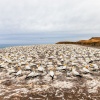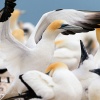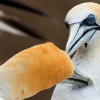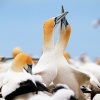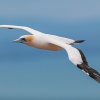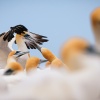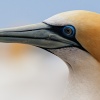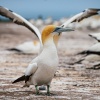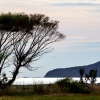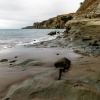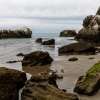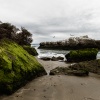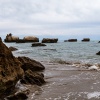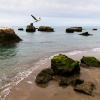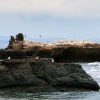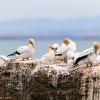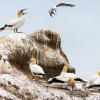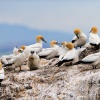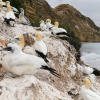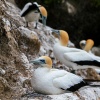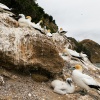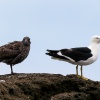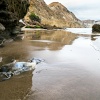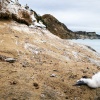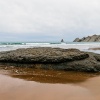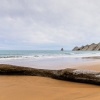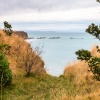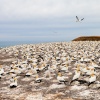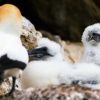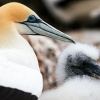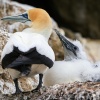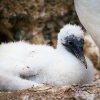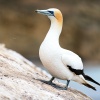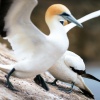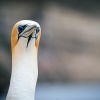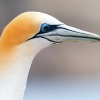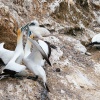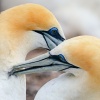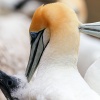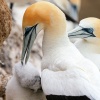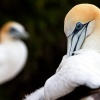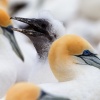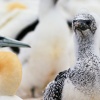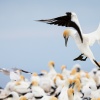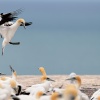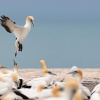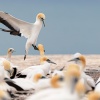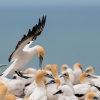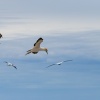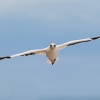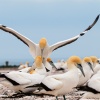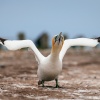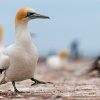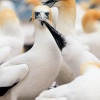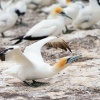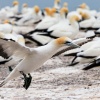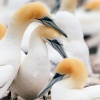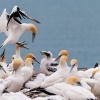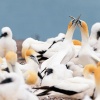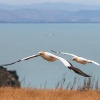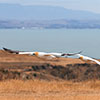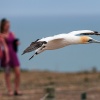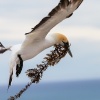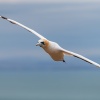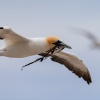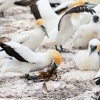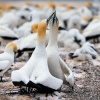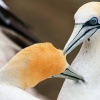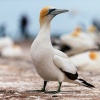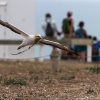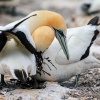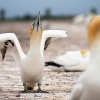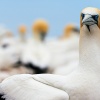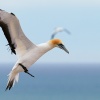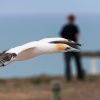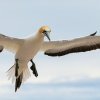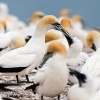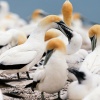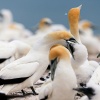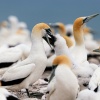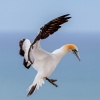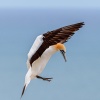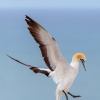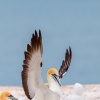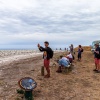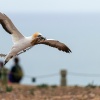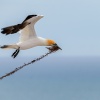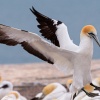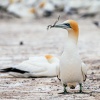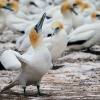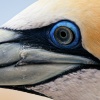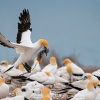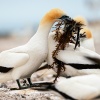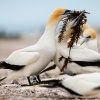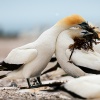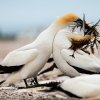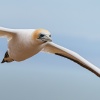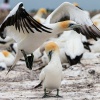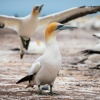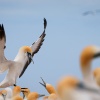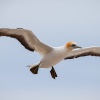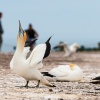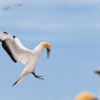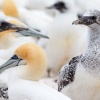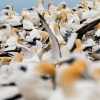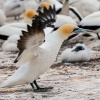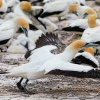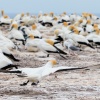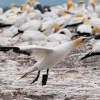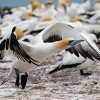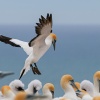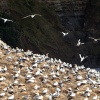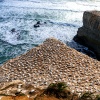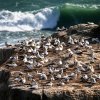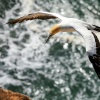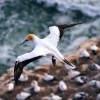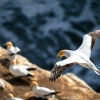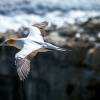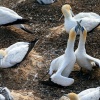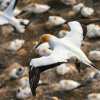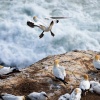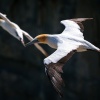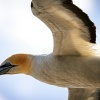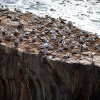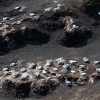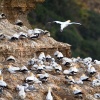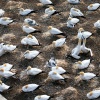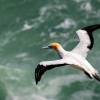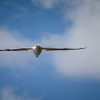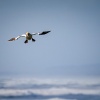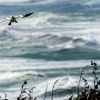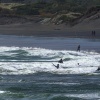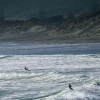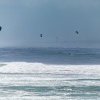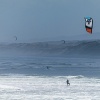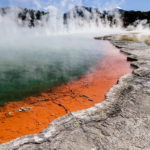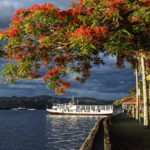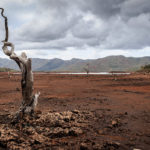The Gannets of Cape Kidnappers and the Trans Tasman Flight
Seabirds are little miracles of evolution and New Zealand is home to a lot of them. At Muriwai Beach and the Cape Kidnappers in Hawke’s Bay I spent days with the second rarest gannet species in the world, the Australasian gannet, who is a master aviator and swift as an arrow hunter when it comes to fish. Their chicks are even tougher as when coming of age having no life and hunting experience they start a life-threatening adventure, the Trans-Tasman flight.
The Gannets at Cape Kidnappers
Yes, I love seabirds and make no bones about that. The bustle happening in their colonies is time-less and everything but boring. Those little guys brave the worst weather, natural enemies as well as the rough conditions on the ocean, while most humans chicken out seeking shelter and even start bellyaching about climate conditions when they already stay in a protected roofed place. Those birds live in in tightest communion with nature, catch only as much food as they need for living and do not endanger or destroy their environment like the human race does.
Beside the omnipresent shags and albatrosses down in the Fiordland National Park (as well as on Otago peninsula) New Zealand has areas where pretty special seabirds are nesting permanently. The talk is about the Australian or Australasian gannet, whose Down Under related name should actually be denominated to the Kiwi land as the majority of its total population, that is ~90%, lives in New Zealand and not Australia. Interesting to know is that Germany and Poland are the only countries in the world calling this bird Tölpel or Głuptaków, literally meaning fool. Well, those little guys are everything but dumb…
The Australasian gannet can become up to 1 metre tall while his wings can span even up to 2 metres. Together with its cousin living in the northern hemisphere, the northern gannet, and its relative nesting at South Africa’s coast, the African Cape gannet, he forms the group of Sulidae Morus, the gannets. Because of the big natural distances between all species it would be very surprising if they could meet each other, except in a zoological garden. Some optical elements do have all three species in common though: the yellow-golden neck plumage, a conical blue-grey beak as well as their trademark, the light blue iris.
Thousands of Kilometres, non-stop
At the age of 4 months the gannet chicks are full-fledged. Without having had any flight practise and no hunting experiences, the young bird starts a tremendous adventure, the Trans-Tasman flight. That journey takes 8 to 14 days and is about 2800 kilometres long. Sadly many of the youngsters do not return from that flight, in good years only 25% make it back to New Zealand’s gannetries as many die due to rough weather and sea conditions or fall an easy prey to natural enemies. Why the birds undertake this hazardous journey is mystery, in particular because Australia’s east coast has no abundant supply of food.
In a human context – let’s assume that a human life lasts some 85 years in the following example – that means a baby would leave the sheltering house in the age of 1.5 years to embark on a thousands of kilometres long journey with potential no return; to boot without knowing how to get food and having walked a single step before. As a 3 year old child they would return to where they grow up to spend the rest of their life (some remaining 17 years) there, in New Zealand. Some of the birds even repeat this journey. Incredible…!
The Land of the Kiwis has 24 gannet colonies, but only 3 of them are on the mainland, hence accessible. The most patronised gannetry, by humans not by birds, is the colony at Muriwai Beach, where the birds are nesting since 1979. Due to having a good infrastructure and being located only about an hour car drive away from Auckland, Muriwai has loads of visitors but also loads of barriers. The often onshore blowing strong winds are a little annoyance as it peels visitor faces with swirled up sand, feather and bird droppings. The second gannetry can be found at Farewell Spit, near Abel Tasman National Park on the south island.
Walking through low and high tide
One of my biggest frustrations in New Zealand is its tourism industry marketing the Land of the Kiwis as pure freedom. I wouldn’t call it freedom when actually everywhere you get asked to pay up for something limited, something lasting half an hour only and something requiring a guide. Well, for 99% of the ordinary people that is ok, as they get the infrastructure to see things they don’t know how to approach, for example on a glacier or somewhere in nature right next to a colony of seabirds, but for professionals those limitations are everything but freedom, they are a creativity choking corset. When I came to Hawke’s Bay experiencing that fate already loomed again as well, since rumours say that it is not allowed to enter the area of Cape Kidnappers, where New Zealand’s third gannetry can be found. Fortunately that is not the case, hence I could visit the nesting area without further costs or being bound to a touristic schedule. However, that piece of real freedom means hiking, which is not a problem for me, so I packed my equipment in the very early morning to make use of the time window provided by already rising tide.
During my stay all conditions where rough; it was windy, rainy and without moments of interesting light. On the other hand the birds stay out there all the time and such days are an inherent part of gannets. Not everything is just sunshine and roses, and that was the photographical challenge I actually wanted, to capture the birds’ life the way it is, at for example diffuse light conditions. After having walked some 8km along the cliff coast I can spot the first arrow-shapes in the sky. They come closer, so does their cackling and their smell but also high tide water.
Walking in high tide affected areas is absolutely nothing for inexperienced hikers. Hence please keep out of the coastal area at high tide. Almost everywhere you can ask the people for the best time window to get to Cape Kidnappers. Yes, I went there differently, but I know my body potential and the location.
The scent of the colony
Yes, 13.000 fish eaters living together on a small crowded spot produce a remarkable stink. At Cape Kidnappers that is the case since 1880, when naturalist Henry Hill mentioned the gannetry’s 50 birds for the first time, but since the Māori know the nesting site under the name of Tākapu it is very likely that the colony is older than 1880. On the other hand such colonies are not permanent as the animals follow food supply and general nesting conditions, which means a colony can move, expand but also die.
January belongs to the main breeding season hence beside the adult gannets’ cackling you hear primarily the squealing buzzing noise of the fluffy chicks that slightly remind of a large cooling unit running somewhere in the background. Some of the nests are pure adventure as they very small or put to the slope. When the egg rolls out or the chick falls down, then the gannet chick is de facto doomed to die as the adults have no chance to bring the egg or chick back to the nest. Seeing dead little gannet bodies lying around is sad, very sad. At Cape Kidnappers you can meet an animal being highly adapted to its habitat. The gannets eyelids, its strong forehead bone and the arrow-shaped body are a masterpiece of evolution. Physically seen whole bird body is aimed on hunting fish on the deep sea. The gannets’ primary food is herring-size fish like sardines or anchovies, also squid is on the menu, but you’ll also spot it bringing kelp at home, for improving its nest.
But a piece of art is their way of hunting, their dive for prey, when they plunge headlong into the water from a height between 1 and 20 metres. In a fraction of a second and being only centimetres away from the water surface, they close their eyes and fold in their wings back to swoop down into the fish like an arrow reaching a speed of up to 145 km/h. How determined and persistent the birds are, shows their approach to the colony as during the landing manoeuvre the bird has a hell of lock on its nest. Nothing can distract it from flying in, even not people standing in the approach corridor.
Busy flight operations
The gannets are masters of gliding and very fast nose-diving, on the land they behave clumsy though, meaning that the actual start and landing are a stories of its own. Properly cued up they stand like planes on Heathrow’s runway waiting to get their clearance for take-off. With heavy wing beats and using both feet they push off themselves from the ground to finally plunge from a cliff like a Japanese Kamikaze and fly away. Their landing manoeuvre, when the bird tries to take the wind out of its sails by flying upright as if it’s swollen with pride, looks gracile but also funny at the same time as the bird literally falls off the sky onto the ground with spread legs ahead.
Some approaching birds look as gentle as a ballet dancer while other landings rather remind of Obelix running into a couple of Roman soldiers. Thus watching such a colony is quite entertaining, also because to see the birds’ getting pinched by the neighbour as soon as a landing wasn’t that precise. Well, feeling that beak surely is not entertaining at all… Having not made it to land, the bird cacklingly flies loops every time saying “Baby, Baby, wait! I come back in a minute!” Relentlessly trying to reach its nest and its partner again and again, the bird’s comeback efforts can easily mean to fly 20 loops or more. Both partners live together a whole bird’s life. Having been away for a short time only, they celebrate their return and inseparable relationship with an intimate and heart-melting ritual. They bill and coo, crane their necks and beaks upwards, cuddle as well as care about its partner’s plumage while sticking their tails out. This tête-à-tête gets even hotter as soon as kelp (nesting material) gets involved. While photographing and enjoying such scenes, a tractor and a bus, chauffeuring tourists over the low tide beach, arrive the cape hill.
Instead of watching the birds those humans start to watch me, because of my big super tele lens. Apparently that view made a grandma experiencing a second spring as unashamedly she tries to get off with me. Well, Prussian granite is too hard for denture wearers. For me it was just irritatingly funny to see people coming for a wildlife experience but then letting distract themselves from what they originally came for. However, soon those people luckily went off again. I am not bound to tractors and busses. I can stay in my tent next to the birds. I can spend the night with them, and, well, with the arriving low pressure remains of what was cyclone “June” before.
Trying to sleep I notice how the storm approaches and the morning after the cape hill now seems to be a swamp. “Sh** p*** f*** rain!” In the face of such weather also the birds are everything but amused, what wrests heavy laugher from me as their faces pretty much reflect what my typical sharp Berlin tongue let me curse last night. It seems that in their hearts gannets are Prussians too :-)))))
Being spangled all over with bird droppings, the ground makes every starting bird slide all over the place. Looking embarrassed and ashamed at each other, the gannets seem to regret that they have ventured out onto the slime as they ruined their plumage. Fortunately the rain washes all dirt away again. I didn’t take much photos and only God knows why I stay for a second night, which turned out to become more wet than lessons in breast-stroke swimming. Having struck my camp and put away the completely soaked tent at 2:00 in the night I sit like a clucking hen with my photo equipment under my old paratrooper poncho, waiting for things to get better. Thanks God, that thing is entirely rainproof…
In the very early morning the tides allow again to wander along the cliff coast beach back to Clifton. By the light of my headlamp I rush towards that one-horse town. Having seen those wonderful free living birds very close and myself, is one of my most intensive New Zealand experiences. They are so cute that I would have loved to take one of them with me :-) Of course I didn’t… Most of the photos shown here got shot with the Canon EF 200-400mm f/4L IS USM lens, an investment I definitely do not regret.
